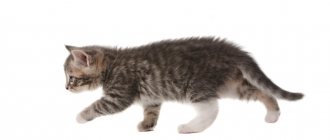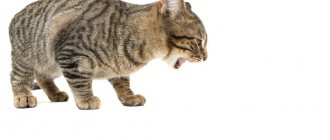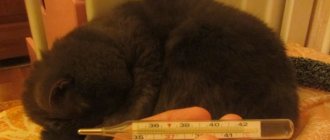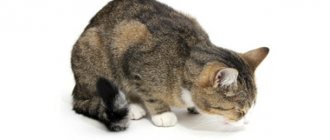When it comes to caring for a cat, there are a few simple tips. By following these tips, you can help your four-legged feline friends stay healthy for decades to come!
- Maintain a safe environment (keep indoors)
- Serve high quality food (such as protein in the form of meat)
- Be mindful of preventive care (such as annual physical exams, laboratory tests, and appropriate vaccines)
- Make sure you are well liked and don’t forget to do special exercises for cats
But you should also know about the five silent killers - the most common cat diseases. Knowing about them, you will understand what symptoms need to be identified and remembered. The sooner you detect these symptoms, the sooner veterinarians can help with treatment.
Chronic kidney disease
One of the most common diseases in cats is chronic kidney disease. Sometimes called chronic kidney failure or chronic kidney injury. These terms are all semantically the same and basically mean that 75% of both kidneys are ineffective and not working.
Symptoms of Chronic Kidney Disease
- Excessive drinking
- Excessive urination
- Large accumulation of fur in a permanent location
- Weight loss
- Poor breath (due to the build-up of toxins in the blood and caused ulcers in the mouth, esophagus and stomach)
- Lethargy
- Stealth
Treatment of chronic kidney disease
Fortunately, with the right help, cats can live with chronic kidney disease for many years (unlike dogs, where the disease usually progresses more quickly). Treatment for chronic kidney disease in cats includes a low-protein diet, frequent blood tests, increasing water intake (such as using a water fountain or serving thawed canned food), medications, and even injecting fluids under the skin (which many pet caregivers do). animals at home when properly trained).
Diagnostics
Diagnosis is associated with confirmation of inflammatory processes in the bile ducts, liver and pancreas and the simultaneous exclusion of other diseases. In particular, triaditis is similar to the early stage of the viral disease panleukopenia, chronic kidney disease, helminthic infestation (especially when owners do not have the opportunity to control the cat’s stool) and a number of other, less common diseases.
The owner can carry out visual diagnostics independently. With triaditis, already in the first days of the disease, the color of the cat’s skin changes. It is enough to look at the inside of the ear. Its color is pale or yellowish-pale will indicate liver problems. The mucous membranes in the mouth also become almost colorless from pink.
Hyperthyroidism
Hyperthyroidism is an endocrine disorder in which the thyroid gland produces too much thyroid hormone. This is seen in middle-aged cats and can lead to very similar symptoms to chronic kidney disease.
Symptoms of hyperthyroidism
- Excessive thirst
- Increased water intake/urination
- Vomiting/diarrhea
- Weight loss
However, since hyperthyroidism increases a cat's metabolism, it differs in one determining factor - a strong appetite despite weight loss. In turn, this can lead to:
- Increased heart rate
- Severe hypertension (leading to acute blood loss, neurological signs, and even blood clot or stroke)
- Secondary organ injury (eg, heart murmur or kidney changes)
Treatment of hyperthyroidism
Fortunately, treatment for hyperthyroidism is very effective and involves either a medication (called methimazole, surgical removal of the thyroid gland (less commonly done), a special prescription diet) or radioactive iodine therapy. For hyperthyroidism, the sooner you begin treatment, the less potential side effects or organ damage your cat will experience.
Treatment of triaditis
Treatment of triaditis in cats begins with the placement of an intravenous catheter. If the animal has healthy kidneys, then sufficient volumes of infusions (depending on the age and weight of the animal), hepatoprotectors, antibiotics and antimicrobials are prescribed.
To relieve inflammation from the walls of the intestines and biliary tract, viscous medicinal compositions can be prescribed. To facilitate the passage of feces and to prevent fecal impaction, the animal is prescribed a mild laxative.
Diabetes
Another costly silent killer that affects cats is diabetes. Because many of our cats are often overweight, they are at greater risk of contracting this disease. In diabetes, the pancreas does not secrete enough insulin (type 1) or there is insulin resistance (type 2). Insulin is a natural hormone that brings sugar (i.e. blood glucose) into cells. As a result of glucose-starved cells, the body produces more and more glucose, causing hyperglycemia (that is, high blood sugar) and many of the symptoms seen in diabetes.
Symptoms of diabetes
Common symptoms of diabetes in cats are similar to those of chronic kidney disease and hyperthyroidism, including:
- Excessive urination and thirst
- Large accumulation of fur in a permanent location
- Overweight or obese body condition with wasted muscles (specifically above the spine or back), or weight loss
- Decreased or strong appetite
- Lethargy or weakness
- Vomit
- Abnormal breathing (eg, acetone breathing)
- Abnormal walking (eg, too close to the ground)
Treatment of diabetes
Treating diabetes can be expensive because it requires twice-daily insulin injections given under the skin. It also requires dietary changes (high protein, low carbohydrate diet), frequent monitoring of blood glucose levels, and frequent visits to veterinarians.
With support and chronic treatment, cats can live quite well; however, once diabetic complications (eg, diabetic ketoacidosis, hyperosmolar, hyperglycemic syndrome) develop, diabetes mellitus can be life-threatening.
With support and chronic treatment, cats can live quite well; however, once diabetic complications (eg, diabetic ketoacidosis, hyperosmolar, hyperglycemic syndrome) develop, diabetes mellitus can be life-threatening.
Frozen Fetus in a Cat Symptoms
Moderator: beauty admin
Signs of fetal freezing?
- Messages: 7
- Registered: Thu Sep 29, 2005 17:16
- From: Moscow, VDNH
- Profile
- Top
- Report this message
VIP
- Messages: 1726
- Registered: Wed Feb 23, 2005 13:48
- Profile
- Top
- Report this message
GOD
- Messages: 16025
- Registered: Wed Oct 19, 2005 16:07
- Profile
- Top
- Report this message
Super VIP
- Messages: 3154
- Registered: Wed Feb 23, 2005 02:34
- Profile
- Top
- Report this message
Super VIP
- Messages: 3171
- Registered: Tue Dec 14, 2004 16:02
- From: Ukraine
- Profile
- Top
- Report this message
Guru
- Messages: 5378
- Registered: Tue Jun 07, 2005 13:14
- From: Peter
- Profile
- Top
- Report this message
how much is small?
Old timer
- Messages: 885
- Registered: Sun Aug 14, 2005 13:48
- From: Moscow
- Profile
- Top
- Report this message
Marmarmalade
- Profile
- Top
- Report this message
Guru
- Messages: 6684
- Registered: Tue Aug 23, 2005 09:16
- From: Moscow
- Profile
- Top
- Report this message
VIP
- Messages: 2450
- Registered: Fri Sep 23, 2005 10:43
- Profile
- Top
- Report this message
Super VIP
- Messages: 3154
- Registered: Wed Feb 23, 2005 02:34
- Profile
- Top
- Report this message
Super VIP
- Messages: 3154
- Registered: Wed Feb 23, 2005 02:34
- Profile
- Top
- Report this message
Super VIP
- Messages: 3154
- Registered: Wed Feb 23, 2005 02:34
- Profile
- Top
- Report this message
Super VIP
- Messages: 3154
- Registered: Wed Feb 23, 2005 02:34
- Profile
- Top
- Report this message
Cat, maybe I'm confusing... didn't you have anembryonics?
If your breasts stop hurting, this is not a sign of a missed pregnancy. A frozen pregnancy can only be determined by ultrasound. Spotting and pain in the lower abdomen are a sign of detachment and tone of the uterus, cat. may also occur during developing pregnancy.
Guru
- Messages: 9105
- Registered: Sat Aug 09, 2003 14:02
- Profile
- Messages: 7
- Registered: Thu Sep 29, 2005 17:16
- From: Moscow, VDNH
- Profile
Heart diseases
Heart disease is very frustrating for both cat owners and veterinarians. This is because while dogs almost always have a loud heart murmur (that is, one that can be heard with a stethoscope) indicating heart disease, cats often do not have a heart murmur. In fact, veterinarians estimate that 50% of cats with heart disease do not have an auscultatory heart murmur.
Symptoms of heart disease
- Heart murmur
- Abnormal heart rhythm
- Fast heart rate
- Collapse
- Fainting
- Increased breathing rate
- Labored breathing
- Bluish gums
- Open breathing through the mouth
- Acute sudden paralysis (eg, hind limbs)
- Cold, painful hindquarters
- Sudden pain
- Sudden lameness
- Sudden death
Treatment of heart disease
Once heart disease is diagnosed (usually based on a physical examination, chest x-ray, or ultrasound of the heart called an “echocardiogram”), treatment may include emergency care such as oxygen therapy, diuretics, and blood pressure and heart support with medications. The long-term prognosis is imprecise because heart medications do not cure heart disease, but only prevent heart disease from getting worse. The exception here is that if the heart disease was caused by hyperthyroidism, in this case, with its treatment, heart disease is not a terrible death sentence.
Pregnancy and childbirth
Treatment of hemorrhoids during pregnancy
According to recent studies, hemorrhoids are an expansion of the choroid plexuses of the anal rectum, and not stagnation of blood in the veins with the formation of their protrusions - nodes. And this is extremely important for understanding the mechanisms of development, treatment and prevention of this serious disease, which often occurs.
High blood pressure during pregnancy has long-term consequences
High blood pressure and associated complications such as eclampsia and preeclampsia affect about 10% of all pregnancies. However, in addition to the negative impact on the mother’s body, high blood pressure can also play a significant role for the child in the womb.
Exacerbation of herpes during pregnancy
Exacerbation of herpes during pregnancy occurs quite often due to a physiological decrease in immunity necessary to prevent fetal rejection.
Recommendations and opinions published on the Site, including materials on the SlimSmile personal diet, ARE NOT A SUBSTITUTE FOR QUALIFIED MEDICAL CARE. Be sure to consult your doctor.
Information materials posted on the site, including articles, may contain information intended for users over 18 years of age in accordance with Federal Law No. 436-FZ of December 29, 2010 “On the protection of children from information harmful to their health and development.”
More details
Cancer
Because dogs and cats tend to live long lives, veterinarians see many cases of cancer. The most common type of cancer in cats is gastrointestinal cancer, often due to lymphosarcoma.
Symptoms of cancer
- Weight loss
- Refusal to eat
- Vomit
- Diarrhea
- Labored breathing
- Abdominal distension or bloating
- Weakness
- Lethargy
- Stealth
- Fever
- Generalized malaise
Cancer treatment
Once diagnosed, the prognosis for complete recovery from cancer is usually poor. For this reason, the sooner you notice symptoms, the sooner diagnosis and treatment will begin.
Prevention measures: how to prevent miscarriage?
Timely preventive measures will help reduce the risk of early or late miscarriage in a cat, as well as prevent life-threatening complications. First of all, the owner needs to prevent the crossing of closely related pairs, since inbreeding often leads to congenital anomalies of intrauterine development and premature birth. You should not breed a too young or elderly female. In the first case, it is important to wait until physiological maturity, which approximately occurs at the age of 1.2-1.5 years. When the cat turns 5 years old, it is better to sterilize it, because age-related changes negatively affect pregnancy and childbirth.
In addition, it is important to prevent injuries, falls, and poisoning. Before mating, it is recommended to examine the cat’s body for the presence of viral infectious diseases, including chronic ones. After conception, it is important to monitor your pet’s diet, give vitamins and other useful supplements on the advice of a veterinarian, stimulate physical activity, and prevent excessive weight gain.
Other hazards
Please note that there are other common emergencies that can lead to death in cats, including injury, urination, poisoning, etc. If you are in doubt but want to keep your animal safe and sound, follow these 5 simple tips:
- Keep your cat indoors to prevent any injury (such as getting hit by a car, being attacked by a dog, being accidentally poisoned, etc.)
- Make sure your cat is at a healthy weight - this can help prevent problems due to obesity such as diabetes
- Be sure to schedule your annual visit to your veterinarian. This is especially important as it can find anomalies faster. Note that even if your cat is indoors, she still needs an annual checkup: you may want to skip some of the vaccines (and schedule them for every third year instead). So don't skip the inspection.
- Keep your cat's litter box clean. Although it sounds obvious, frequent and daily cleaning of the litter box is a must. Not only will this alert you to life-threatening emergencies such as feline urolithiasis, it will allow you to notice if your cat is urinating more or less than usual.
- Contact your veterinarian as soon as you notice any clinical signs, not several months after your cat is drinking and urinating more than usual, but immediately.
When it comes to your cat's health, make sure you're aware of these silent killers. The sooner you notice symptoms, the sooner the doctor can conduct a blood test and diagnose the disease. The sooner the disease is diagnosed, the faster the veterinarian can cure it!
Giving birth to a cat, recommendations
Home birth is indicated for normal pregnancy: the cat does not experience stress from a change in environment, and the risk of contracting an infection is reduced to zero. The veterinarian is called only in special cases.
Induction of labor
They resort to it when gestation is prolonged. No amateur activities or folk methods, which often lead to long labor and injury to the cervix, for example, with self-administration of oxytocin. Only the doctor will decide whether it is necessary to induce labor and what means are needed. If stimulation is unavoidable, the cat will be injected with a hormone that acts as a catalyst for contractions.
First birth
They are considered the most complex in terms of physiology and psychology: a woman in labor can panic, demand help from the owner, or, conversely, rush at him and hiss.
The owner is also somewhat confused and needs the support of a veterinarian who can calm the cat by injecting it with a sedative that reduces stress levels.
Duration of labor
The owner of the cat should not be concerned about the duration of labor that has begun, but about possible deviations. Call “aibolit” if:
- contractions occur, but the kitten does not come out for more than an hour;
- it is clear that the fruit is stuck;
- the cat's temperature is above 39.5°C or below 37°C;
- copious, bloody, foul-smelling and purulent discharge appeared;
- the animal weakens, barely breathes and lies down, not trying to expel the fetus;
- the heart rhythm goes astray.
Call your doctor if you don't know what to do next.
Start of labor
Do not turn childbirth into a show: do not comment on what is happening and do not invite guests. If the cat allows, lightly stroke the sides and back towards the tail. For a long-haired woman in labor (to prevent the babies from getting tangled), it is better to wrap her tail with a bandage. During contractions, waves will pass through her body, and her stomach will begin to bulge and tense . The stormy preparatory phase promises a rapid birth. Sometimes it takes longer for the firstborn to appear than for subsequent kittens.
Assistance during childbirth
An experienced or confident person can help a giving birth cat. And help is required in case of weak contractions, improper positioning of the fetus, large size of the newborn, or absence of contractions.
Important! If the bladder is ruptured, you can (wearing surgical gloves) get the kitten out, waiting for the next contraction, pulling it in an arc towards the stomach. Don't grab his head or paws!
Stimulating contractions is allowed only when the cervix is fully dilated. The owner can:
- lightly, without pressure, massage the tummy (in a circle) in the direction from the chest to the vulva;
- gently massage the nipples;
- attach one kitten to your chest so that it eats;
- With the index finger inserted (up to the 2nd phalanx) into the vagina, gently stroke the wall opposite the anus.
If things don't work out, it's best to call your veterinarian.
Help for newborns
If the birth took place without an emergency, the cat itself licks the cubs and bites off the umbilical cord, sometimes eating a couple of placentas . The owner must ensure that all children's seats are out: if this does not happen, call a doctor for help.
If the newborn is not breathing, you need to:
- remove mucus from the nose/mouth with a syringe;
- wrap the kitten in a waffle napkin and massage its back from tail to neck;
- after clearing the nose of mucus, quickly swab cotton wool with ammonia around it;
- you can put a drop of cognac on your tongue;
- if there are no signs of life, wrap it in a waffle napkin and, holding the head, shake gently;
- perform mouth-to-nose artificial respiration (taking into account the tiny size of the lungs).
If the woman in labor has not chewed the umbilical cord, help her:
- Squeeze the umbilical cord with your fingers 2 cm from the tummy.
- Hold firmly for 15 seconds to compress the vessels.
- Cut the umbilical cord at the point of compression, making sure that no blood is released.
- If blood is oozing, tie the umbilical cord with a disinfected thread 1.5 cm from the abdomen.
- Lubricate the tip with brilliant green or potassium permanganate.
Give the reanimated baby to his mother. If your cat has successfully delivered the baby, you won't need a special box for kittens.









